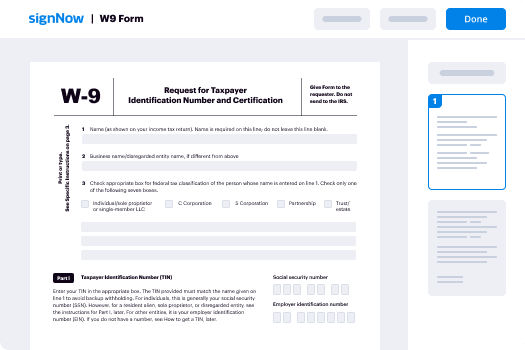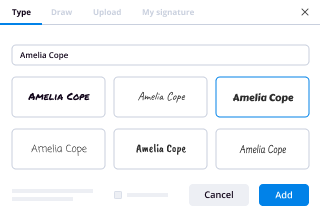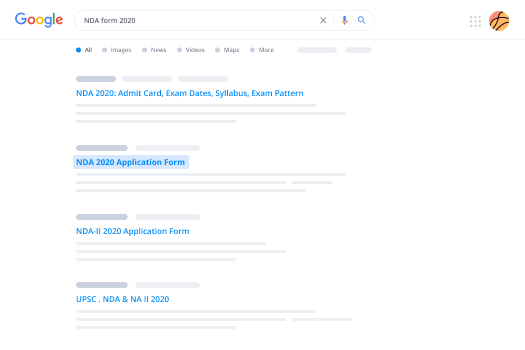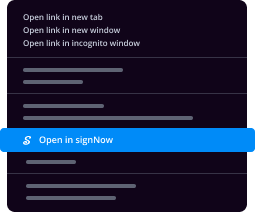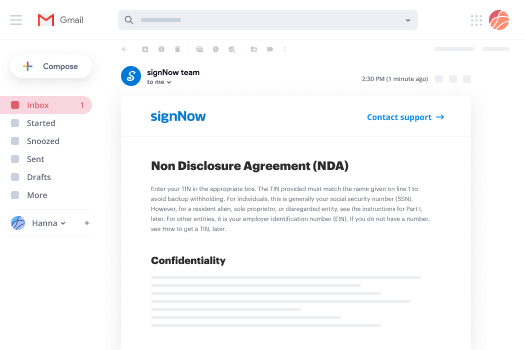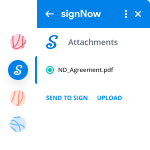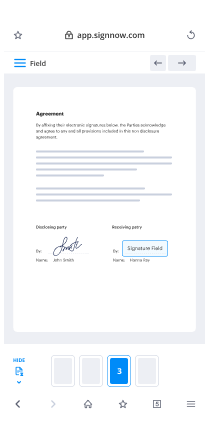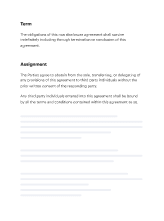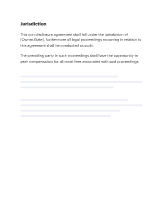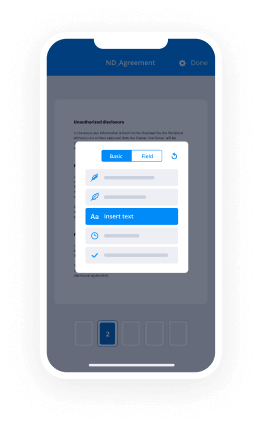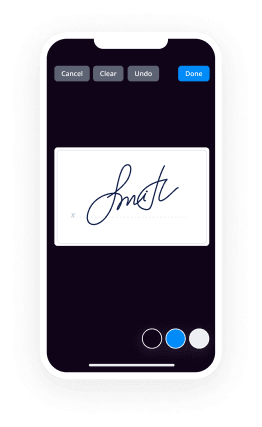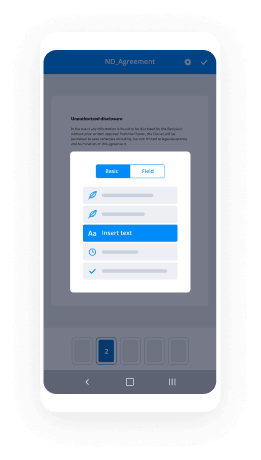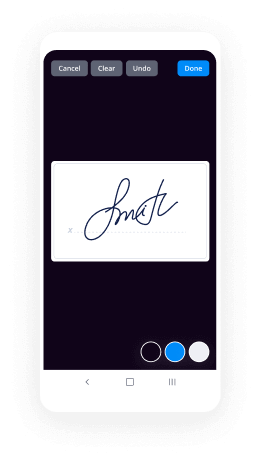Explore Your Digital Signature – Questions Answered: Digital Signature Algorithm Example
- Quick to start
- Easy-to-use
- 24/7 support
Simplified document journeys for small teams and individuals




We spread the word about digital transformation
Why choose airSlate SignNow
-
Free 7-day trial. Choose the plan you need and try it risk-free.
-
Honest pricing for full-featured plans. airSlate SignNow offers subscription plans with no overages or hidden fees at renewal.
-
Enterprise-grade security. airSlate SignNow helps you comply with global security standards.







Quick-start guide on how to use digital signature algorithm example feature
Is your business ready to cut inefficiencies by about three-quarters or higher? With airSlate SignNow eSignature, weeks of contract negotiation turn into days, and hours of signature collecting turn into minutes. You won't need to learn everything from the ground up due to the intuitive interface and easy-to-follow guides.
Complete the following steps listed below to use the digital signature algorithm example functionality in a matter of minutes:
- Launch your web browser and access signnow.com.
- Subscribe for a free trial or log in using your electronic mail or Google/Facebook credentials.
- Select User Avatar -> My Account at the top-right corner of the page.
- Personalize your User Profile with your personal data and adjusting configurations.
- Design and manage your Default Signature(s).
- Return to the dashboard page.
- Hover over the Upload and Create button and choose the appropriate option.
- Click the Prepare and Send key next to the document's title.
- Type the name and email address of all signers in the pop-up screen that opens.
- Use the Start adding fields menu to proceed to modify document and self sign them.
- Click SAVE AND INVITE when you're done.
- Continue to configure your eSignature workflow employing extra features.
It can't get any easier to use the digital signature algorithm example feature. It's available on your mobile devices as well. Install the airSlate SignNow application for iOS or Android and manage your customized eSignature workflows even while on the go. Skip printing and scanning, labor-intensive submitting, and costly papers shipping.
How it works
Rate your experience
What is the digital signature algorithm example
A digital signature algorithm example refers to a specific method used to create a digital signature, which is a cryptographic technique that ensures the authenticity and integrity of a digital message or document. Digital signatures are essential in electronic transactions, providing a way to verify the identity of the signer and confirm that the document has not been altered after signing. Common algorithms used for digital signatures include RSA (Rivest-Shamir-Adleman), DSA (Digital Signature Algorithm), and ECDSA (Elliptic Curve Digital Signature Algorithm). Each of these algorithms employs unique mathematical principles to generate a pair of keys: a private key for signing and a public key for verification.
How to use the digital signature algorithm example
To use a digital signature algorithm example, you typically follow these steps: First, generate a key pair using the chosen algorithm. The private key is kept secure by the signer, while the public key is shared with recipients. When signing a document, the signer creates a hash of the document content, which is then encrypted using the private key to create the digital signature. This signature is attached to the document. Recipients can verify the signature by decrypting it with the public key and comparing the hash with a newly generated hash of the document. If both hashes match, the document is verified as authentic and unchanged.
Steps to complete the digital signature algorithm example
Completing a digital signature algorithm example involves several key steps:
- Choose a digital signature algorithm, such as RSA or DSA.
- Generate a key pair: a private key for signing and a public key for verification.
- Prepare the document you wish to sign.
- Create a hash of the document using a hashing algorithm like SHA-256.
- Encrypt the hash with your private key to create the digital signature.
- Attach the digital signature to the document.
- Share the document with the intended recipients, providing them with your public key for verification.
Legal use of the digital signature algorithm example
In the United States, digital signatures are legally recognized under the Electronic Signatures in Global and National Commerce (ESIGN) Act and the Uniform Electronic Transactions Act (UETA). These laws establish that electronic signatures have the same legal standing as handwritten signatures, provided they meet certain criteria. To ensure legal compliance, users should utilize secure digital signature algorithms that provide adequate authentication and integrity measures. It is also important to maintain proper records of the signing process, including timestamps and audit trails, to support the validity of the digital signature in case of disputes.
Security & Compliance Guidelines
When implementing a digital signature algorithm example, adhering to security and compliance guidelines is crucial. Users should ensure that the private key is stored securely, using hardware security modules (HSM) or secure key management practices. Regularly updating software and algorithms to protect against vulnerabilities is also important. Compliance with industry standards, such as the National Institute of Standards and Technology (NIST) guidelines, can help maintain the security of the digital signature process. Additionally, organizations should conduct regular audits and training to ensure all personnel understand the importance of security in electronic transactions.
Digital vs. Paper-Based Signing
Digital signing offers several advantages over traditional paper-based signing. It streamlines the signing process, allowing documents to be signed quickly and efficiently from anywhere, reducing the need for physical presence. Digital signatures enhance security through encryption and authentication, making it difficult for unauthorized parties to forge signatures. Furthermore, digital documents can be easily stored, managed, and retrieved, minimizing physical storage requirements and reducing environmental impact. Organizations can also track the signing process in real-time, providing better visibility and accountability compared to paper-based methods.
-
Best ROI. Our customers achieve an average 7x ROI within the first six months.
-
Scales with your use cases. From SMBs to mid-market, airSlate SignNow delivers results for businesses of all sizes.
-
Intuitive UI and API. Sign and send documents from your apps in minutes.
FAQs
-
What is a digital signature algorithm example?
A digital signature algorithm example refers to a specific method used to create a digital signature, ensuring the authenticity and integrity of a document. Common examples include RSA and DSA, which utilize cryptographic techniques to secure electronic signatures. Understanding these algorithms can help businesses choose the right eSigning solution.
-
How does airSlate SignNow implement digital signature algorithms?
airSlate SignNow uses advanced digital signature algorithms to ensure that every signed document is secure and verifiable. By employing industry-standard algorithms, we provide users with a reliable way to authenticate their documents. This enhances trust and compliance in digital transactions.
-
What are the benefits of using a digital signature algorithm example in eSigning?
Using a digital signature algorithm example in eSigning offers numerous benefits, including enhanced security, reduced fraud risk, and improved document integrity. These algorithms ensure that only authorized users can sign documents, making the process both secure and efficient. This is crucial for businesses looking to streamline their operations.
-
Is airSlate SignNow compliant with digital signature regulations?
Yes, airSlate SignNow is fully compliant with digital signature regulations, including eIDAS and ESIGN Act. Our platform utilizes robust digital signature algorithms to meet legal standards, ensuring that your signed documents are legally binding. This compliance is essential for businesses operating in regulated industries.
-
What features does airSlate SignNow offer related to digital signatures?
airSlate SignNow offers a variety of features related to digital signatures, including customizable signing workflows, real-time tracking, and secure storage. Our platform supports multiple digital signature algorithm examples, allowing users to choose the best fit for their needs. These features enhance user experience and streamline document management.
-
Can I integrate airSlate SignNow with other applications?
Absolutely! airSlate SignNow offers seamless integrations with various applications, including CRM systems, cloud storage, and productivity tools. This allows users to incorporate digital signature algorithms into their existing workflows easily. Integrating our solution enhances efficiency and simplifies document handling.
-
What is the pricing structure for airSlate SignNow?
airSlate SignNow offers flexible pricing plans tailored to meet the needs of businesses of all sizes. Our plans include features that utilize digital signature algorithms, ensuring you get the best value for your investment. You can choose a plan that fits your budget while benefiting from our secure eSigning capabilities.
airSlate SignNow capabilities for digital signature algorithm example
Related searches to digital signature algorithm example
Join over 28 million airSlate SignNow users
Get more for digital signature algorithm example
- ESignature Licitness for Non-Compete Agreement in ...
- ESignature Licitness for Non-Compete Agreement in UAE
- ESignature Licitness for Non-Compete Agreement in India
- ESignature Licitness for General Partnership Agreement ...
- ESignature Licitness for Non-Compete Agreement in ...
- Unlock eSignature Licitness for General Partnership ...
- ESignature licitness for General Partnership Agreement ...
- ESignature Licitness for General Partnership Agreement ...





























